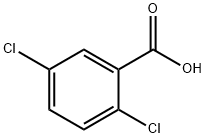|
|
| | 2,5-Dichlorobenzoic acid Basic information |
| Product Name: | 2,5-Dichlorobenzoic acid | | Synonyms: | 2,5-DICHLOROBENZOIC ACID;RARECHEM AL BO 0355;2,5-dichloro-benzoicaci;1,2-DICHLOROBENZENE PESTANAL;2,5-Dichlorobenzoic acid, 98+%;2,5-Dichlorobe;2,5-Dichlorobenzoic acid ,99%;2,5-Dichlorobenzoic acid,97% | | CAS: | 50-79-3 | | MF: | C7H4Cl2O2 | | MW: | 191.01 | | EINECS: | 200-065-7 | | Product Categories: | C7;Carbonyl Compounds;Carboxylic Acids;DAlphabetic;Alpha sort;D;DIA - DIC;Aromatic Carboxylic Acids, Amides, Anilides, Anhydrides & Salts;intermediate;Pesticides&Metabolites;Phenylacetic acid;Organic acids;Acids & Esters;Chlorine Compounds;bc0001 | | Mol File: | 50-79-3.mol |  |
| | 2,5-Dichlorobenzoic acid Chemical Properties |
| Hazard Codes | Xi | | Risk Statements | 36/37/38 | | Safety Statements | 26-36-24/25 | | WGK Germany | 3 | | RTECS | DG6825000 | | TSCA | Yes | | HS Code | 29163900 |
| | 2,5-Dichlorobenzoic acid Usage And Synthesis |
| Chemical Properties | Needle crystals or white crystalline powder. Soluble in ethanol and ether, soluble in hot water. Some volatilize in the vapor. | | Uses | 2,5-Dichlorobenzoic acid was used as calibration standard to investigate the gas-phase OH reaction products of biphenyl, monochlorobiphenyl and dichlorophenyl | | Application | 2,5-Dichlorobenzoic acid is used in organic synthesis and pesticide intermediates. It is used to synthesize herbicides chloramben, 2,5-Dichloro-3-nitrobenzoic acid, etc. The pesticide has less phytotoxicity and is not affected by rainy days. | | Preparation | 2,5-Dichlorobenzoic acid is obtained by reacting p-dichlorobenzene with phosgene to obtain 2,5-dichlorobenzoyl chloride, which is then hydrolyzed. | | Definition | ChEBI: 2,5-dichlorobenzoic acid is a chlorobenzoic acid that is benzoic acid in which the ring hydrogens at positions 2 and 5 are substituted by chloro groups. It is a chlorobenzoic acid and a dichlorobenzene. | | General Description | Needles (from water) or white powder. | | Air & Water Reactions | Insoluble in water. | | Reactivity Profile | Carboxylic acids donate hydrogen ions if a base is present to accept them. They react in this way with all bases, both organic (for example, the amines) and inorganic. Their reactions with bases, called "neutralizations", are accompanied by the evolution of substantial amounts of heat. Neutralization between an acid and a base produces water plus a salt. Carboxylic acids with six or fewer carbon atoms are freely or moderately soluble in water; those with more than six carbons are slightly soluble in water. Soluble carboxylic acid dissociate to an extent in water to yield hydrogen ions. The pH of solutions of carboxylic acids is therefore less than 7.0. Many insoluble carboxylic acids react rapidly with aqueous solutions containing a chemical base and dissolve as the neutralization generates a soluble salt. Carboxylic acids in aqueous solution and liquid or molten carboxylic acids can react with active metals to form gaseous hydrogen and a metal salt. Such reactions occur in principle for solid carboxylic acids as well, but are slow if the solid acid remains dry. Even "insoluble" carboxylic acids may absorb enough water from the air and dissolve sufficiently in 2,5-Dichlorobenzoic acid to corrode or dissolve iron, steel, and aluminum parts and containers. Carboxylic acids, like other acids, react with cyanide salts to generate gaseous hydrogen cyanide. The reaction is slower for dry, solid carboxylic acids. Insoluble carboxylic acids react with solutions of cyanides to cause the release of gaseous hydrogen cyanide. Flammable and/or toxic gases and heat are generated by the reaction of carboxylic acids with diazo compounds, dithiocarbamates, isocyanates, mercaptans, nitrides, and sulfides. Carboxylic acids, especially in aqueous solution, also react with sulfites, nitrites, thiosulfates (to give H2S and SO3), dithionites (SO2), to generate flammable and/or toxic gases and heat. Their reaction with carbonates and bicarbonates generates a harmless gas (carbon dioxide) but still heat. Like other organic compounds, carboxylic acids can be oxidized by strong oxidizing agents and reduced by strong reducing agents. These reactions generate heat. A wide variety of products is possible. Like other acids, carboxylic acids may initiate polymerization reactions; like other acids, they often catalyze (increase the rate of) chemical reactions. | | Fire Hazard | Flash point data for 2,5-Dichlorobenzoic acid are not available; however, 2,5-Dichlorobenzoic acid is probably combustible. | | Purification Methods | Crystallise the acid from water. [Beilstein 9 IV 1005.] Aromatic acid impurities (to <0.05%) can be removed via the (±)-�-methylbenzylamine salt as described for 2,4-dichlorobenzoic acid [Ley & Yates Organic Process Research & Development 12 120 2008.] |
| | 2,5-Dichlorobenzoic acid Preparation Products And Raw materials |
| Raw materials | Potassium permanganate-->Paraformaldehyde-->1,2,4-Trichlorobenzene-->p-Dichlorobenzene-->2,5-DICHLOROBENZOYL CHLORIDE-->2,5-Dichlorobenzonitrile-->METHYL 2,5-DICHLOROBENZOATE-->1,4-DICHLORO-2-IODOBENZENE-->2',5'-Dichloroacetophenone-->2,5-DICHLOROTOLUENE | | Preparation Products | Irsogladine-->2,3-DICHLOROBENZAMIDE-->2,4,5-Trichlorobenzoic acid-->2-(2,5-DICHLORO-PHENYL)-BENZOOXAZOL-5-YLAMINE |
|